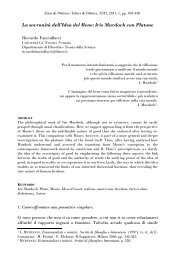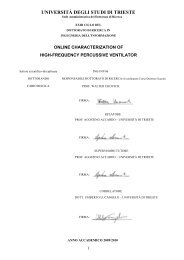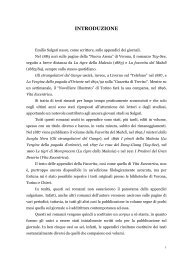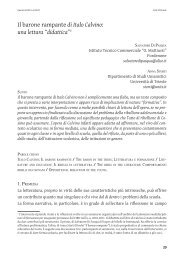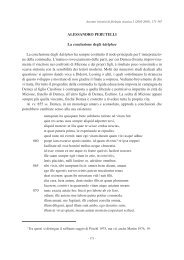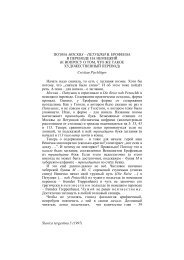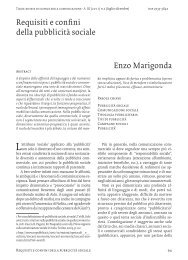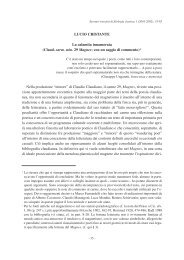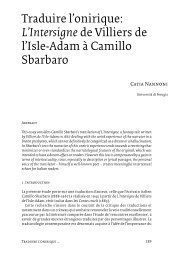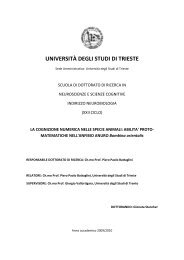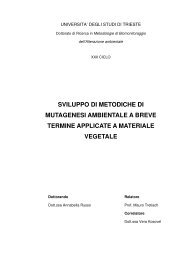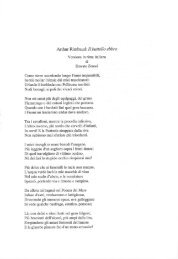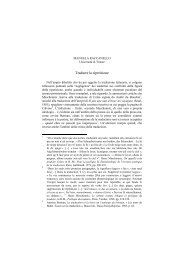Horizontal denominative variation in an EU victim ... - OpenstarTs
Horizontal denominative variation in an EU victim ... - OpenstarTs
Horizontal denominative variation in an EU victim ... - OpenstarTs
You also want an ePaper? Increase the reach of your titles
YUMPU automatically turns print PDFs into web optimized ePapers that Google loves.
monol<strong>in</strong>gual texts, as the st<strong>an</strong>dpo<strong>in</strong>t from which the phenomenon was exam<strong>in</strong>ed<br />
was ma<strong>in</strong>ly term<strong>in</strong>ological. In l<strong>in</strong>e with the m<strong>in</strong>ority of scholars tackl<strong>in</strong>g<br />
the specific phenomenon of term<strong>in</strong>ological <strong>variation</strong> from a contrastive po<strong>in</strong>t<br />
of view (cf. for example Merkel 1998, Rogers 2004, Rogers 2008) <strong>an</strong>d unlike<br />
ma<strong>in</strong>stream research, the purpose of the present study is to take <strong>in</strong>to consideration<br />
a parallel corpus made of Europe<strong>an</strong> Union texts deal<strong>in</strong>g with the crim<strong>in</strong>al<br />
law subfield related to the role of the <strong>victim</strong> <strong>in</strong> crim<strong>in</strong>al proceed<strong>in</strong>gs <strong>in</strong> two l<strong>an</strong>guages,<br />
English <strong>an</strong>d Itali<strong>an</strong>, <strong>in</strong> order to verify – from a tr<strong>an</strong>slational viewpo<strong>in</strong>t –<br />
the presence of a s<strong>in</strong>gle aspect of term<strong>in</strong>ological <strong>variation</strong>, i.e. <strong>denom<strong>in</strong>ative</strong><br />
<strong>variation</strong>.<br />
The paper is structured as follows: Section 2 presents a brief chronological<br />
overview of different term<strong>in</strong>ological schools of thought question<strong>in</strong>g the univocity<br />
pr<strong>in</strong>ciple postulated by the traditional theory of term<strong>in</strong>ology; Section 3<br />
<strong>in</strong>troduces the concept of <strong>denom<strong>in</strong>ative</strong> <strong>variation</strong>; Section 4 describes the case<br />
study on a specific form of <strong>variation</strong>, i.e. horizontal <strong>denom<strong>in</strong>ative</strong> <strong>variation</strong>;<br />
Section 5 concludes the paper <strong>an</strong>d suggests what future work should address.<br />
2. From monosemy to polysemy <strong>an</strong>d synonymy<br />
The birth of term<strong>in</strong>ology as a discipl<strong>in</strong>e dates back to the 1930s, when specialized<br />
lexicographic work was performed by subject field experts, must prom<strong>in</strong>ently<br />
by eng<strong>in</strong>eers such as Wüster, the developer of what is now considered<br />
the traditional term<strong>in</strong>ology theory, <strong>in</strong> order to meet the need for st<strong>an</strong>dardization<br />
of the pr<strong>in</strong>ciples <strong>an</strong>d methods used <strong>in</strong> term<strong>in</strong>ology m<strong>an</strong>agement, thus suggest<strong>in</strong>g<br />
<strong>an</strong> overall prescriptive approach to the term<strong>in</strong>ological discipl<strong>in</strong>e.<br />
The result<strong>in</strong>g st<strong>an</strong>dardization activity, which differentiates itself from traditional<br />
lexicographic work because of its object of study – terms rather th<strong>an</strong><br />
words – <strong>an</strong>d of its onomasiological rather th<strong>an</strong> semasiological approach,<br />
focused on the compilation of repositories of term<strong>in</strong>ological data – subject field<br />
concepts <strong>an</strong>d their designations – <strong>in</strong>tended to normalize exist<strong>in</strong>g terms so as to<br />
elim<strong>in</strong>ate ambiguities <strong>an</strong>d assure unambiguous, effective <strong>an</strong>d efficient communication<br />
among subject-field professionals. In order to consider terms from<br />
such a l<strong>an</strong>guage pl<strong>an</strong>n<strong>in</strong>g perspective, they necessarily need to fulfill the socalled<br />
univocity pr<strong>in</strong>ciple, accord<strong>in</strong>g to which there is a one-to-one relationship<br />
between a concept <strong>an</strong>d the term designat<strong>in</strong>g it, as synonymy <strong>an</strong>d polysemy are<br />
l<strong>in</strong>guistic phenomena to be avoided <strong>in</strong> specialized communication: a st<strong>an</strong>dpo<strong>in</strong>t<br />
shared not only by the Wüsteri<strong>an</strong> Vienna school, but also by the Prague<br />
<strong>an</strong>d the Soviet school.<br />
However, term<strong>in</strong>ological <strong>variation</strong> is <strong>an</strong> observable l<strong>in</strong>guistic phenomenon<br />
<strong>an</strong>d Wüster (1979) himself did not deny the existence of synonyms with<strong>in</strong> l<strong>in</strong>guistic<br />
communities work<strong>in</strong>g <strong>in</strong> the same field of knowledge, although he considered<br />
them a d<strong>an</strong>ger compromis<strong>in</strong>g effective communication. The first<br />
br<strong>an</strong>ch of term<strong>in</strong>ology to accept <strong>an</strong>d try to cope with term<strong>in</strong>ological <strong>variation</strong>,<br />
albeit always with<strong>in</strong> a st<strong>an</strong>dardiz<strong>in</strong>g approach, was developed <strong>in</strong> Quebec <strong>in</strong> the<br />
1980s (cf. for example Duquet-Picard 1983, Duquet-Picard 1986, Auger 1994):<br />
C<strong>an</strong>adi<strong>an</strong> term<strong>in</strong>ologists adopted a sociol<strong>in</strong>guistic perspective from which vari-<br />
178



